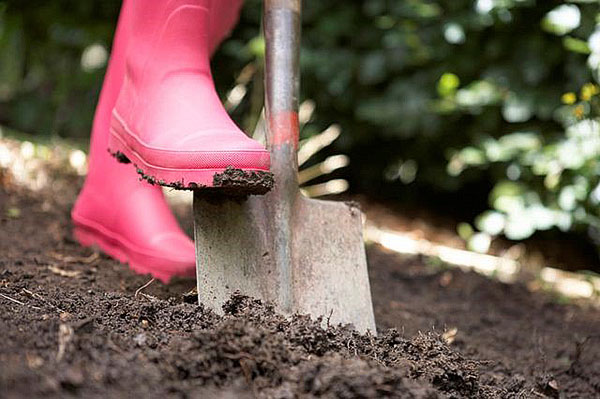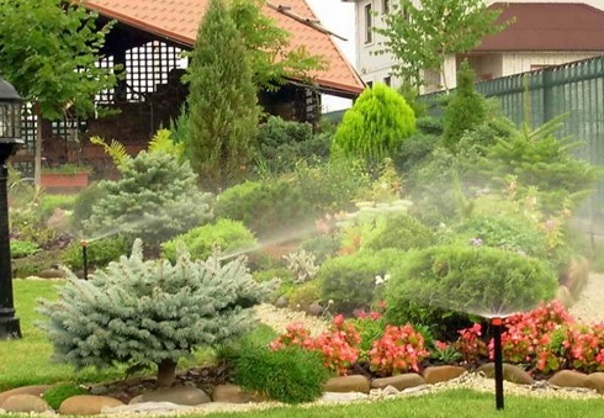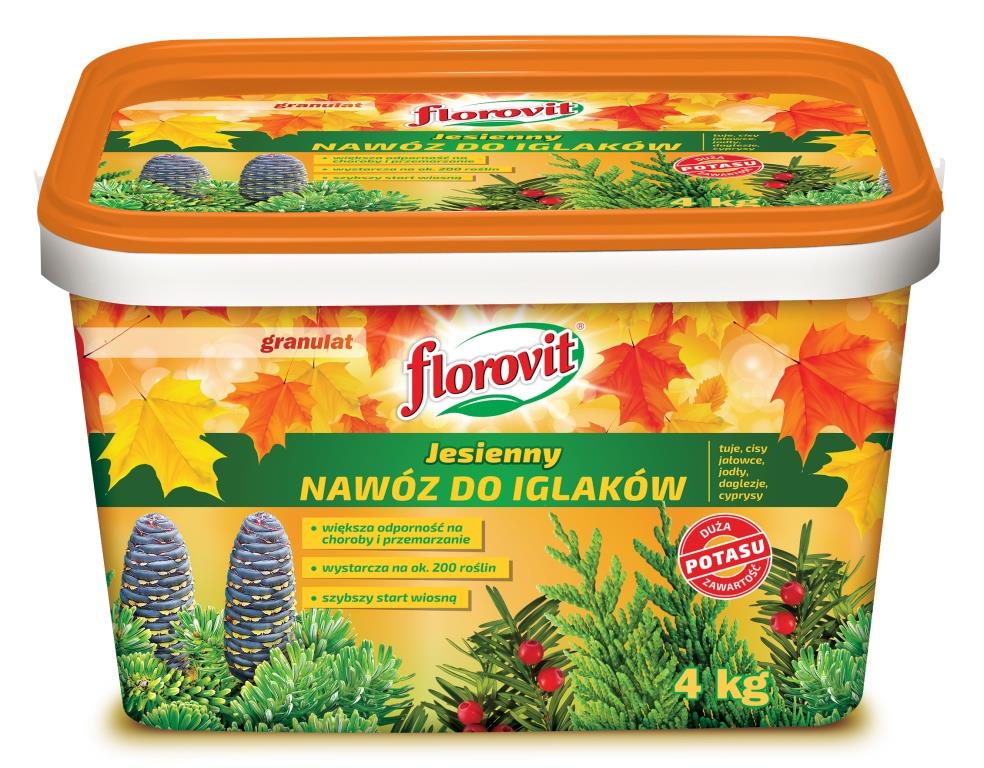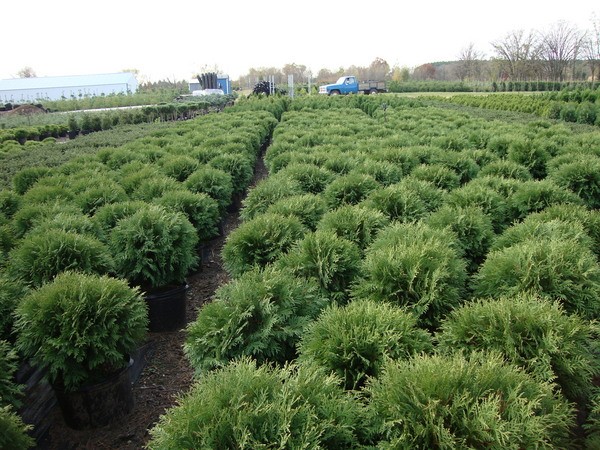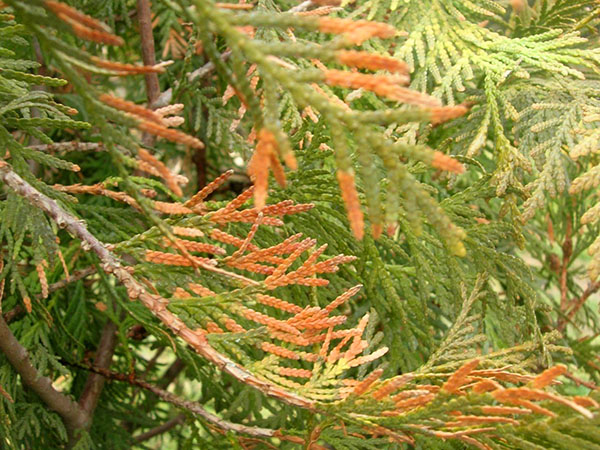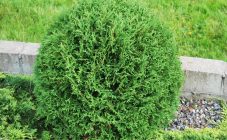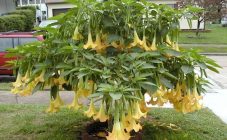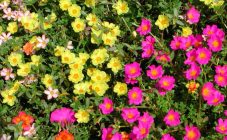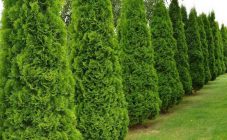Content:
It is difficult to imagine modern landscape design without conifers. They are always actively used in squares and parks, in private gardens. Thuja also belongs to evergreen conifers. Its other name is life tree. Thuja belongs to the Juniper family. Among its many varieties, thuja western Woodwardii (Thuja occidentalis Woodwardii) has earned great love.
Characteristics of the variety
This is a fairly old, proven variety that was introduced in the early 20th century. The history of the appearance of thuja Woodwardi is not known for certain, but some scientists suggest that it was brought to Europe from the USA or East Asia. There it was appreciated and actively used in landscape design. Thuja later reached Russia.
The main difference between Woodwardy is a spectacular thick crown in the shape of a ball. The color of the shoots is rich, bright and can vary from light green to dark green.
In the description of the western thuja Woodwardi says that it grows rather slowly. At the age of 10, it looks like a neat shrub about half a meter in height and the same in diameter. As the thuja branches grow, they move apart more to the sides and the crown acquires an ovoid oval shape with a diameter of up to 3 m. The height of an adult Woodwardy thuja can be up to 2.5 m.The age of the tree reaches up to 150 years.
Thuja planting
The place for the landing of thuja Woodwardi should be sunny. However, do not forget that it does not tolerate direct sunlight well, therefore, during the period of greatest solar activity, the tree should be in the shade. Thuja also tolerates penumbra well, but in such conditions, its needles can become thicker and narrower, and the crown loses its attractiveness quite significantly.
There are also certain soil requirements that are important to observe before planting. It should be light with a slight admixture of sand and peat. If there is a lot of sand, you need to dilute it with clay. If the soil is heavy, then it is worth arranging a drainage with a depth of at least 15-20 cm. Also, do not forget about compost.
It is best to plant thuja Woodwardy in spring, so that by winter the seedling has time to take root and get stronger. Autumn planting is also allowed.
If you plan to plant several plants, for example, along an alley, then the distance between them should be at least 50 cm, and preferably about 1 m. Be sure to carefully dig up the ground from weeds.
The size of the planting pit depends on the earthen ball or root system of the seedling. It should be 15-30 cm deeper and 35-40 cm wider. Drainage is laid at the bottom of the pit, if necessary. Next, a soil mixture with the addition of manure or compost and, finally, the plant itself is established with a lump of earth.
If a small seedling is planted, then the roots should first be placed in water. When air bubbles stop rising from their surface, you can move the stalk to the very center of the hole and gently cover it with soil mixture. Squeeze the soil slightly on all sides and pour abundantly. The amount of watering depends on the size of the plant, it is approximately from 1 to 5 buckets.
When the moisture is absorbed and the soil settles, you need to put a layer of mulch. This can be hay, bark, wood chips or peat. Mulch will prevent moisture evaporation, and also protect against the negative effects of too high or low temperatures.
Further care
The measures for the further care of Woodwardi thuja include:
Watering
Thuja just needs moist soil. Watering is carried out once a week at least 10-15 liters per plant. In dry season - 2 times a week. Do not forget to loosen the soil after watering. The roots of the thuja are superficial, so this should be done carefully, no more than 8-10 cm in depth.
In addition to watering, Woodwardi's thuja responds very well to sprinkling, since the needles actively evaporate moisture. It is necessary to periodically spray the crown with water, this will cleanse it of dust, and the air will be filled with a pleasant coniferous aroma.
In general, it is very important to water the thuja in a timely manner and in sufficient quantities throughout the summer season, since a dehydrated plant winters worse.
Top dressing
In order for the beautiful thuja to please with a thick and bright crown, regular feeding is required. If fertilizers were applied during planting, the next time you can do this after 2 years. For this, manure, compost or complex fertilizers for conifers on a potassium-phosphorus basis are suitable. Mineral fertilizers reduce the pH of the soil, which negatively affects the condition of the thuja. Top dressing is correct and convenient during loosening. Usually one time is enough in the middle of summer.
Wintering
Thuja Woodwardi perfectly tolerates winter in Russia and can withstand frosts down to -35 ° C. You just need to properly prepare the plant for wintering. Here are the basic rules:
- It is recommended to insulate the trunk circle with spruce branches or a thick layer of sawdust.
- For the first 2-3 years, a young plant can be severely affected by bright sunlight in late winter and early spring. To prevent this from happening, it is imperative to protect the thuja with a covering material or burlap. It can be removed only after the snow melts, in cloudy weather.
- It is enough to shade an adult plant with a net or other suitable material.
- For the wintering period, the crown must be pulled together with a tape so that heavy snowfalls or wet snow do not damage the branches.
In addition to the above-described mechanical methods of protecting thuja from burns, there are also chemical agents. They are easier to use and can make plant maintenance easier. The drug is applied by spraying and creates a protective film on the needles of the plant. This film protects shoots from burns, prevents moisture from evaporating from the surface, keeping it inside.
Pruning
Until the age of 10, Woodwardi's thuja itself is well formed into a beautiful ball, but a corrective haircut is still needed to get the ideal shape. Also, pruning is done for sanitary purposes and is done as needed.
Thuja responds well to pruning, and the more often it is produced, the thicker and more magnificent its crown becomes. It is best to carry out the procedure in March - April before the kidneys open. At this time, there is still a lot of moisture in the tree and the sections heal very quickly.
The first time they cut their hair when they reach 2-3 years of age. To maintain the spherical shape, 2-3 bearing branches are left. Don't be too zealous.It is important to remember: so that the tree does not weaken, do not cut more than 1/3 of the stem.
Sanitary pruning involves removing diseased, dry, or yellowed branches. Incorrectly growing shoots are also removed.
Reproduction of thuja Woodwardi
There are 2 types of thuja breeding: vegetative and seed. As a rule, the seed method is used only if the plant is species. This process is very long, taking 3-5 years. In this case, the characteristics of the parent plant are not preserved.
An affordable and widely used method for breeding thuja is cuttings. To do this, in April, you need to cut off a lignified stem with the heel of no more than 40 cm in size. The cut site of the donor plant should be treated with a solution of heteroauxin or garden varnish. The needles were removed from the lower part of the cutting and placed in a solution of any rooting agent for 12 or more hours according to the instructions. Instead of a solution, you can use sphagnum, it retains moisture well and helps to fight fungal infections.
Then you can plant the cutting in the prepared potting mix. Sod land, sand and peat are best suited for thuja. Some experts advise to disinfect it by spilling it with a slightly warm solution of potassium permanganate. The seedling should be deepened by no more than 2.5 cm and immediately be sure to cover with a jar, plastic bottle or film. In no case should the planted stalk be left in direct sunlight. It is ideal to arrange diffused sunlight.
The fact that rooting has taken place will be evidenced by new shoots. Only after that, you can begin to air and temper the seedlings, and after a while you can remove the shelter for good. In late autumn, when the temperature drops to -5 ° C, mini-bushes are covered with spruce branches or foliage, and a film is still applied over the winter.
By the same principle, you can grow thuja at home, creating greenhouses for cuttings. In such conditions, rooting and growth are more confident and faster.
Diseases and pests
Thuja Woodwardi, like many other coniferous shrubs and trees, suffers from various ailments and parasites:
- Phytophthora fungus. The bark becomes soft, white or pink spots appear. Roots rot, and the crown looks weak and painful. With such a disease, the plant is destroyed. Soil must also be removed.
- Tinder fungus. This disease is manifested by growths of the fungus on the trunk and visible rotten areas of the bark. As a rule, the diseased plant dies. Trimming the affected areas of the bark and treating the cuts with linseed oil can help.
- Fungal diseases brown schütte and cytosporosis. It affects stems and needles. In the fight against them, Bordeaux liquid or kartocid helps.
- Very often thuyu affects various types of aphids, speckled moth and spider mite... The presence of these pests is manifested by a change in the color of the needles to orange or brown, and in the future, and its fall. The branches are drying up. When a tick appears, a visible cobweb. At the initial stage, the tree is treated with soapy water. If there are too many parasites, insecticides are used. Good results are obtained by treating wood with caterpillar glue and spraying with a solution of colloidal sulfur.
Thuja Woodwardi in landscape design
Thuja western Woodwardy is very actively used in landscape design. A beautiful little ball always attracts the eye. It is versatile and can be used in both group and single landings.
- Thuja Woodwardii is perfect for landscaping indoor and outdoor terraces, as well as balconies. When creating an alpine slide, you should definitely take it as an accent.
- Planted along paths or retaining walls, Woodwardi's thuja will become an exquisite living border on the site.
- Due to its low growth, this beautiful tree will serve as an underbrush in a group of tall trees, when creating a natural landscape.
- Mixborder Woodwardy and various varieties of thuja with the addition of other shrubs will look very elegant and natural at the same time.
Yes, the thuja of this variety grows slowly, but even a small height looks spectacular on the site. In addition, it does not require special measures in terms of care and planting, so its cultivation is within the power of even a novice gardener.

